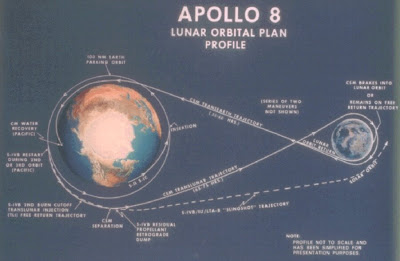
Date: December 21-27, 1968
Crew: Commander Frank Borman (40)
Command Module Pilot Jim Lovell (40)
Lunar Module Pilot Bill Anders (35)
Command Module Name: CM-103
Service Module Name: SM-103
Mission Distinctions: First manned launch of a Saturn V rocket. First manned space flight to leave the gravitational field of planet Earth and travel to our satellite. The first humans to journey to the moon for a “circumlunar” tour! The crew took the first pictures of Earth from deep space, first live television footage of the lunar surface, and the craft set a new speed record: 24,200 MPH.
It's impossible to overstate the historical significance of Apollo 8. Borman, Lovell and Anders were the first human beings to witness and personally photograph an "Earthrise." Their mission was the most widely covered by the media since the first American orbital flight by John Glenn in 1962. Over 1200 journalists covered the mission, which was broadcast in 54 countries in 15 languages. The Apollo 8 broadcasts later won an Emmy.
Famed pilot Charles Lindbergh visited the crew the day before they launched.
In the first successful "translunar injection," it was the goal of Apollo 8 to test all craft facilities, communications, mid-course corrections and consumables for a possible landing mission. They were also tasked with taking clear photographs of proposed future landing sites and locations of scientific interest on the Moon.

The Lunar Orbital Plan. Click to enlarge...
At the 69 hour mark, the propulsion system ignited and burned for what the crew would later describe as "the longest four minutes of our lives." If the burn was not precisely accurate, they could be flung off into space; if it last too long, they could crash into the moon. After ensuring they did achieve a proper path, they finally had a chance to look at the Moon, which they would orbit 10 times for the next 20 hours.
Jim Lovell’s first impression of the moon was that, "It looks like plaster of paris, or sort of grayish beach sand."
Upon the recovery after splashdown, helicopter pilot Don Jones asked what the moon was truly made of cheese? Frank Borman quipped, "It’s not made of green cheese, it’s American cheese."
 Personally, one of my favorite mission insignia designs, as it showed home, the goal away from home, the trajectory in an interesting incorporation of the mission number... and it’s the only one in the shape of an Apollo Capsule.
Personally, one of my favorite mission insignia designs, as it showed home, the goal away from home, the trajectory in an interesting incorporation of the mission number... and it’s the only one in the shape of an Apollo Capsule.Currently, the Apollo 8 command module is on display at the Museum of Science and Industry in Chicago, Illinois.


































































